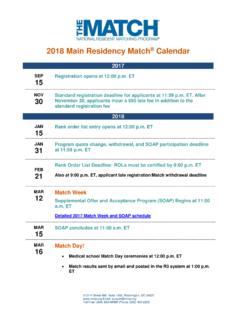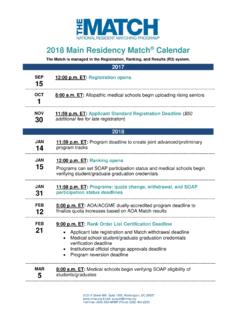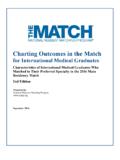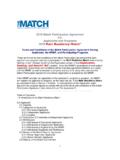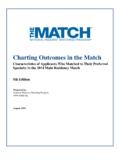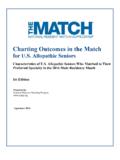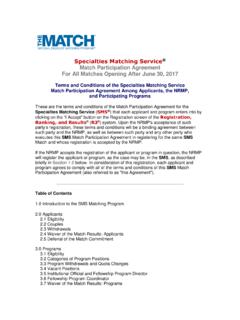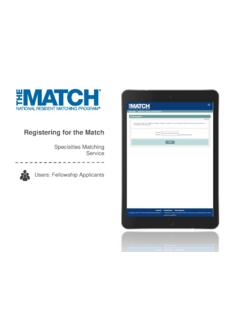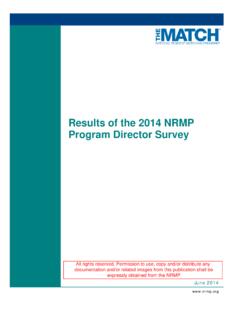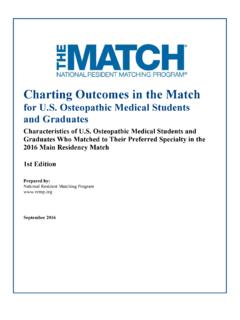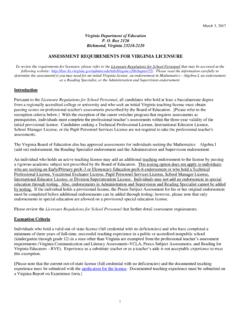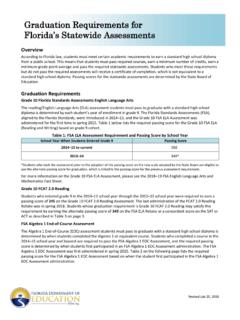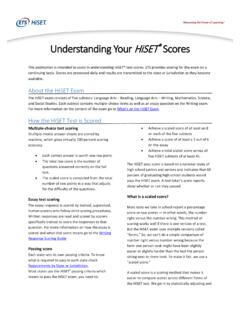Transcription of Charting Outcomes in the Match
1 Charting Outcomes in the Match :Senior Students of MD Medical SchoolsCharacteristics of MD Seniors Who Matched to Their Preferred Specialty in the 2020 Main Residency Match2nd EditionPrepared by:National Resident Matching 2020 Questions about the contents of this publication may be directed to National Resident Matching Program, (202) 400-2233 or about the NRMP should be directed to Donna L. Lamb, , , , President and CEO, National Resident Matching Program, (202) 400-2233 or 2020 National Resident Matching Program, 2121 K Street, NW, Suite 1000, Washington, DC 20037 USA. All rights reserved. Permission to use, copy and/or distribute any documentation and/or related images from this publication shall be expressly obtained from the Resident Matching Program, Charting Outcomes in the Match : Senior Students of Medical Schools, 2020.
2 National Resident Matching Program, Washington, DC 2020. 2020 Table of Contents Introduction .. ii Tables and Charts for All Specialties Chart 1. Active Applicants in the 2020 Main Residency Match .. 2 Table 1. Number of Applicants and Positions in the 2020 Main Residency 3 Chart 2. Ratio of MD Seniors Ranking Specialty First / Available Positions .. 4 Chart 3. Match Rates of MD Seniors .. 5 Table 2. Summary Statistics on MD Seniors .. 6 Chart 4. Median Number of Contiguous Ranks of MD Seniors .. 7 Chart 5. Mean Number of Different Specialties Ranked of MD Seniors .. 8 Chart 6. USMLE Step 1 Scores of MD Seniors .. 9 Chart 7. USMLE Step 2 CK Scores of MD Seniors .. 10 Chart 8. Mean Number of Research Experiences of MD Seniors.
3 11 Chart 9. Mean Number of Abstracts, Presentations, and Publications of MD Seniors .. 12 Chart 10. Mean Number of Work Experiences of MD Seniors .. 13 Chart 11. Mean Number of Volunteer Experiences of MD Seniors .. 14 Chart 12. Percentage of MD Seniors Who are Members of AOA .. 15 Chart 13. Percentage of MD Seniors Graduating from One of the 40 Medical Schools with the Highest NIH Funding .. 16 Chart 14. Percentage of MD Seniors Who Have a Graduate Degree .. 17 Tables and Charts for Individual Specialties Anesthesiology .. 18 Child Neurology .. 27 Dermatology .. 36 Diagnostic Radiology .. 45 Emergency Medicine .. 54 Family Medicine.
4 63 General Surgery .. 72 Internal Medicine .. 81 Internal Medicine/Pediatrics .. 90 Interventional Radiology .. 99 Neurological Surgery .. 108 Neurology .. 117 Obstetrics and Gynecology .. 123 Orthopaedic Surgery .. 135 Otolaryngology .. 144 Pathology .. 153 Pediatrics .. 162 Physical Medicine and Rehabilitation .. 171 Plastic Surgery .. 180 Psychiatry .. 189 Radiation Oncology .. 198 Vascular Surgery .. 207 iCopyright 2020 NRMP. Reproduction prohibited without the written permission of the Outcomes in the Match : MD Seniors, 2020 2020 IntroductioniiCopyright 2020 NRMP.
5 Reproduction prohibited without the written permission of the first edition of Charting Outcomes in the Match was published in August 2006 to document how applicant qualifications affectsuccess in the Main Residency Match . The report was published biennially between 2007 and 2011 and was a collaboration of theNational Resident Matching Program (NRMP ) and the Association of American Medical Colleges (AAMC ). Match outcome data from the NRMP were combined with applicant characteristics from the AAMC s Electronic Residency Application Service (ERAS ) and United States Medical Licensing Examination (USMLE ) scores from the AAMC data warehouse. Starting with the 2014 MainResidency Match , the NRMP added a Professional Profile section to its Match registration process to collect the USMLE scores and otherapplicant characteristics, and those have been used to independently produce all subsequent Charting Outcomes in the Match reports.
6 Prior to 2016, this report examined the Match success of only two applicant groups: senior students from MD medical schools (" seniors" or " MD seniors") and independent applicants. Independent applicants included all applicant types other than seniors: graduates of MD medical schools, students/graduates of DO medical schools, students/graduates of Fifth Pathway programs, students/graduates of Canadian medical schools, and citizen and non citizen students/graduates of international medical schools (IMGs). Because independent applicants are a heterogeneous group, a decision was made in 2016 to report data separately for MD medical school seniors, students/graduates of DO medical schools, citizen students/graduates of international medical schools, and non citizen students/graduates of international medical schools.
7 In 2018, upon requests from DO medical schools, the Charting Outcomes in the Match report was redesigned to including only senior students of DO medical schools (" DO seniors"), eliminating the reporting on DO graduates because their numbers are so small. The 2020 Charting Outcomes in the Match reports marks the second iteration of publications for MD Seniors, DO seniors and citizen IMGs. This report examines the characteristics of MD success, specialty preference, and ranking information were collected through the Main Residency Match . The 40 medical schools receiving the highest totals of National Institutes of Health (NIH) grants were obtained from the NIH website.
8 Other applicant characteristics, including USMLE Step 1 and Step 2 Clinical Knowledge (CK) scores, academic degrees, publications, Alpha Omega Alpha Honor Medical Society (AOA) membership, and research, and work and volunteer experiences, were self-reported through the Professional Profile section of the NRMP s Applicant Registration Form for the Match . To complete the form, applicants were asked to answer the questions as they did in their ERAS Common Application Form (CAF). Completion of the form was optional, and applicants who completed the form could consent or decline to participate in NRMP research. Data collection for the self-reported Professional Profile section was granted exemption by the Chesapeake (now Advarra) Institutional Review Board (IRB).
9 A total of 19,326 MD seniors submitted certified rank order lists in the 2020 Main Residency Match . After excluding the percent of MD seniors who did not give consent to participate in NRMP research, 17,932 applicants were included in the final dataset. Missing data were found in Step 1 scores ( missing), Step 2 CK scores ( ), number of research experiences ( ), number of abstracts, presentations, and publications ( ), number of work experiences ( ), number of volunteer experiences ( ), degree ( ), other graduate degree ( ), and AOA membership ( ). To ensure that USMLE Step scores were not misreported, the NRMP asked medical schools to verify the scores of their MD seniors.
10 In 2020, 91 percent of the Step 1 scores and Step 2 CK scores used in this report were verified, corrected, or supplied by medical schools. Because the self-reported scores are highly accurate (the intracorrelation coefficient (ICC) between the self-reported scores and school-verified scores was (99% CI [ , ]) for Step 1 scores and (99% CI [ , ]) for Step 2 CK scores), both verified and unverified scores were used to prepare this report. MethodsSpecialties that offered 50 or more positions in the 2020 Main Residency Match are included in this report. Over the years, specialties have been added to the report, including Otolaryngology and Neurology in 2007, Neurological Surgery in 2009, Child Neurology and Vascular Surgery in 2014, and Interventional Radiology in 2018.
